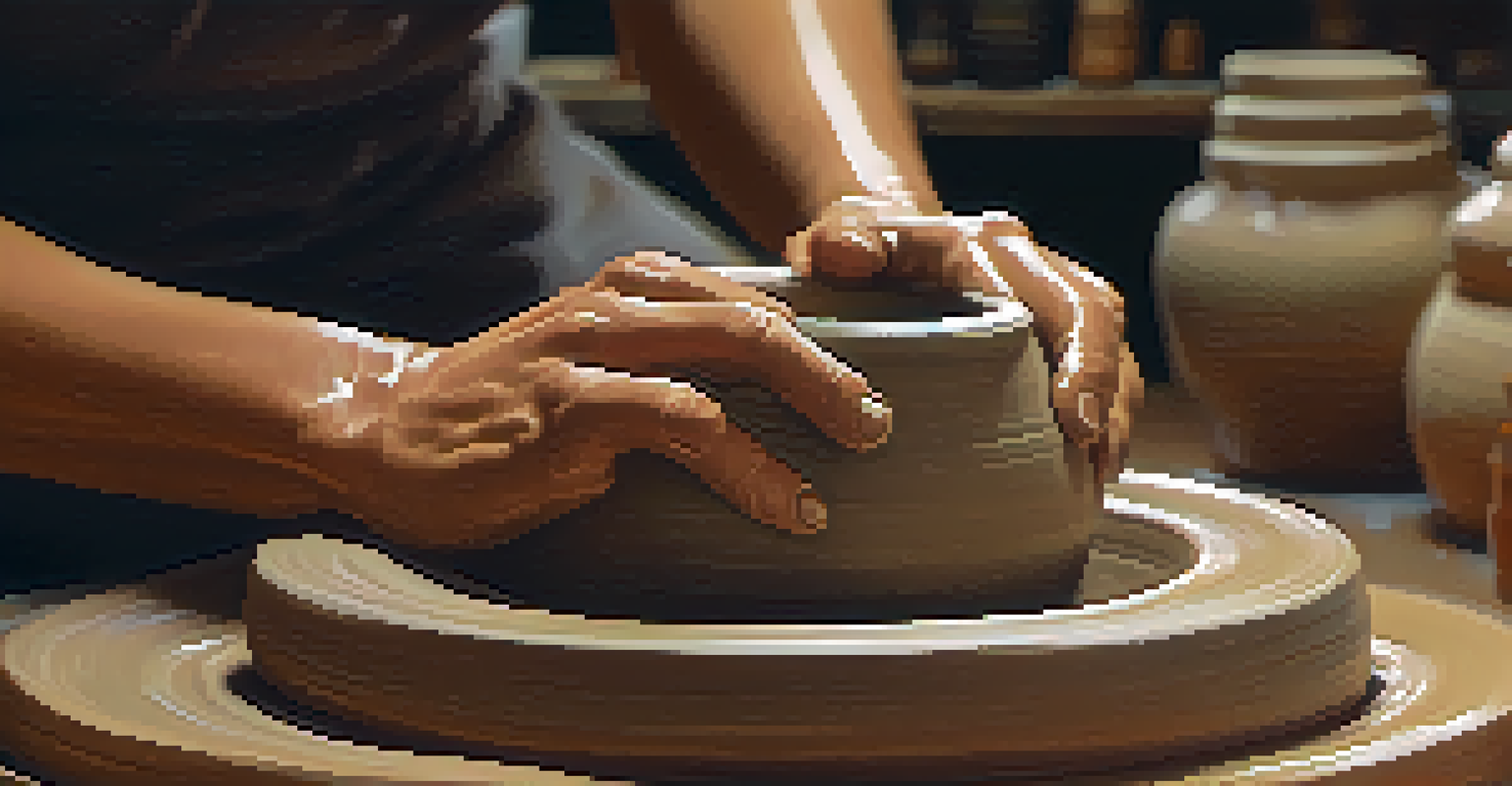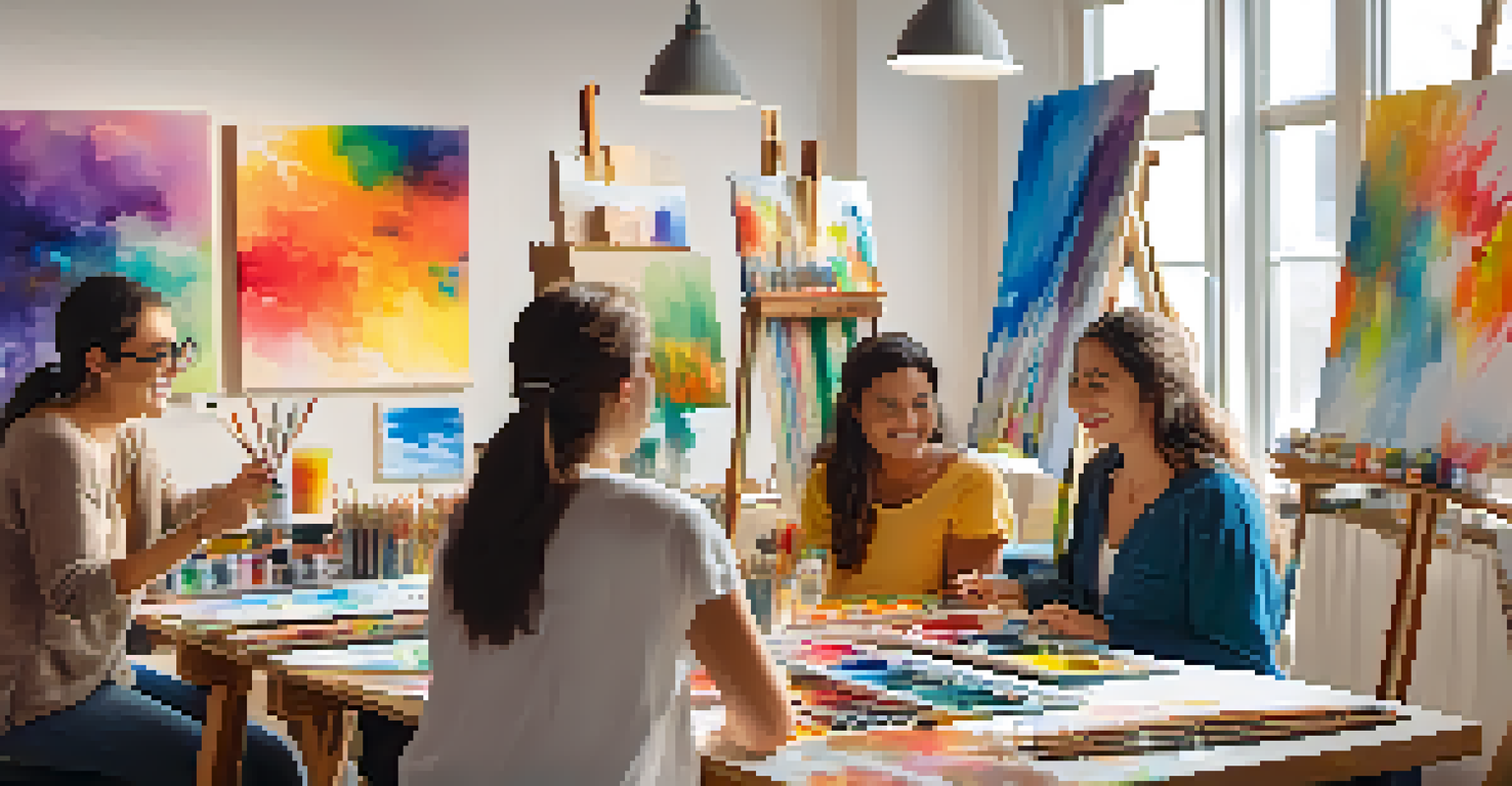Art Therapy: Creative Expression as a Tool Against Addiction

Understanding Art Therapy and Its Benefits
Art therapy is a therapeutic technique that uses creative expression to help individuals process emotions and experiences. Unlike traditional talk therapy, it allows people to communicate through art, which can be especially beneficial for those who struggle to express themselves verbally. This form of therapy can lead to profound insights and emotional healing, making it a valuable tool in the fight against addiction.
Art is not what you see, but what you make others see.
For many, addiction is deeply tied to unexpressed feelings and traumas. Art therapy provides a safe space for individuals to explore these emotions without judgment. By engaging in creative activities, clients can visualize their struggles and begin to understand the underlying causes of their addiction.
Moreover, art therapy can foster a sense of accomplishment and self-worth. Completing a piece of art can enhance one’s confidence, making it easier to tackle the challenges associated with recovery. This sense of achievement can be a crucial motivator in the journey toward healing.
How Art Therapy Works in Addiction Recovery
Art therapy operates on the principle that creativity can facilitate emotional release and healing. During sessions, individuals might engage in drawing, painting, or sculpting, allowing their subconscious thoughts and feelings to surface. This process encourages self-reflection and can lead to breakthroughs that traditional therapies might not achieve.

Additionally, art therapy often integrates mindfulness techniques, helping clients stay present and focused. By concentrating on the act of creation, individuals can momentarily escape the cravings and stressors associated with their addiction. This mindfulness aspect can be incredibly grounding, offering a valuable coping mechanism.
Art Therapy Aids Emotional Healing
Art therapy allows individuals to express emotions creatively, leading to significant insights and emotional healing.
Furthermore, working alongside a qualified art therapist ensures that the process is guided and supportive. These professionals can help clients navigate their artistic expressions, providing insights and interpretations that deepen the therapeutic experience. This collaboration can create a powerful bond, enhancing the overall effectiveness of recovery.
The Role of Creativity in Healing
Creativity plays a significant role in the healing process, as it allows individuals to explore different aspects of their identity. For those battling addiction, reconnecting with their creative side can reignite passions that may have been suppressed during their struggles. This rediscovery not only provides joy but also serves as a reminder of their capabilities beyond addiction.
Creativity takes courage.
Moreover, engaging in creative activities can serve as a healthy distraction from cravings and negative thoughts. When individuals immerse themselves in the creative process, they often find relief from stress and anxiety, which are common triggers for substance use. This shift in focus can be incredibly beneficial in maintaining sobriety.
Lastly, creativity fosters community and connection, which are vital components of recovery. Group art therapy sessions allow participants to share their creations and experiences, building camaraderie and support among individuals facing similar challenges. This sense of belonging can significantly enhance motivation and resilience in overcoming addiction.
Personal Stories: Success Through Art Therapy
Many individuals have found success in their recovery journeys through art therapy, and their stories are both inspiring and relatable. One participant, after years of battling alcohol addiction, discovered painting as an outlet for her emotions. Through this creative process, she was able to confront her past and express feelings that she had long buried.
Another individual shared how sculpting helped him channel his anger and frustration in a constructive way. Instead of resorting to substances, he now finds solace in shaping clay, which serves as both a therapeutic practice and a new hobby. These personal narratives highlight the transformative power of art therapy in fostering healing and growth.
Creativity Supports Addiction Recovery
Engaging in creative activities helps individuals manage cravings and fosters a sense of accomplishment during recovery.
These stories remind us that recovery is not a linear path but a journey filled with ups and downs. Art therapy offers a unique and profound way for individuals to reconnect with themselves and their emotions, ultimately leading to healthier coping mechanisms and a renewed sense of purpose.
Choosing the Right Art Therapy Program
Selecting the right art therapy program is crucial for maximizing its benefits in the recovery process. It's important to look for programs led by licensed and experienced art therapists who can tailor the approach to individual needs. Researching credentials and reading reviews can provide insight into the quality of the program.
Additionally, consider the therapeutic environment. A supportive and welcoming atmosphere can significantly enhance the experience. Some programs may offer group sessions, while others focus on one-on-one therapy — understanding personal preferences can help in making the best choice.
Lastly, it’s vital to recognize that art therapy is just one part of a comprehensive recovery plan. Combining it with other forms of therapy, such as counseling or support groups, can create a more holistic approach to healing. This multifaceted strategy can lead to more sustainable recovery outcomes.
The Science Behind Art Therapy
Research has shown that art therapy can have significant psychological benefits, especially for those dealing with addiction. Studies indicate that engaging in creative activities can reduce stress, anxiety, and depression — all of which are often intertwined with addiction. The act of creating art stimulates the brain's reward system, releasing feel-good chemicals that can help counteract cravings.
Furthermore, art therapy can enhance emotional regulation, helping individuals learn to manage their feelings more effectively. By expressing emotions through art, clients can gain insights into their triggers and develop healthier coping mechanisms. This understanding is key in preventing relapse and promoting long-term recovery.
Personal Stories Highlight Success
Many recovery journeys are transformed through art therapy, showcasing its powerful impact on healing and self-discovery.
Neuroscience also supports the practice, revealing that creative expression activates various parts of the brain associated with emotional processing and self-awareness. This connection between creativity and brain function underscores the importance of including art therapy as a valuable tool in addiction recovery programs.
Conclusion: Embracing Creativity in Recovery
In conclusion, art therapy presents a powerful avenue for individuals seeking recovery from addiction. By harnessing the power of creative expression, clients can explore their emotions, uncover hidden traumas, and develop healthier coping strategies. This innovative approach not only aids in healing but also fosters a renewed sense of identity and purpose.
As we’ve seen through personal stories and scientific research, the benefits of art therapy extend beyond traditional therapeutic methods. It's a holistic practice that nurtures the mind, body, and spirit, making it a valuable component of any recovery journey. Embracing creativity can lead to profound transformations and lasting change.

Ultimately, art therapy encourages individuals to reclaim their narratives and rediscover the joy of self-expression. In the fight against addiction, it serves as a reminder that healing is possible, and with the right tools, anyone can begin to rewrite their story.